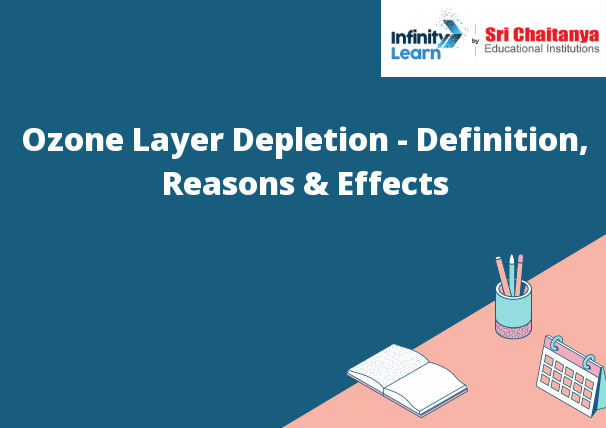Table of Contents
Ozone Layer Depletion
Ozone Layer Depletion – Definition: The ozone layer is a layer in the Earth’s atmosphere that contains high concentrations of ozone gas. The ozone layer helps protect the Earth from the sun’s harmful ultraviolet radiation.
- The ozone layer is slowly being depleted due to human activities. Ozone-depleting substances (such as chlorofluorocarbons [CFCs]) are released into the atmosphere and react with the ozone gas to form ozone-depleted air. This air is then transported around the globe, where it destroys more ozone gas.
- The ozone layer is slowly being repaired, but it will take many years for it to return to its original state. In the meantime, the Earth’s inhabitants are at risk of increased exposure to ultraviolet radiation.

What is the Ozone Layer?
The ozone layer is a region of the Earth’s atmosphere that contains high concentrations of ozone (O3). It is located in the stratosphere, from about 10 to 50 kilometers (6 to 31 miles) above the Earth’s surface. The ozone layer helps protect the Earth from the sun’s ultraviolet radiation.
What is the Ozone Layer Depletion?
- The ozone layer depletion is a phenomenon that results from the depletion of ozone in the Earth’s stratosphere. The ozone layer is a region of the stratosphere that contains high concentrations of ozone gas. The ozone layer depletion is a concern because ozone is a greenhouse gas and it absorbs ultraviolet radiation from the sun. Ultraviolet radiation is harmful to human beings and can cause skin cancer.
- The ozone layer depletion is a phenomenon that is gradually harming the earth’s atmosphere. The layer is made up of ozone gas, which is a form of oxygen. The gas is beneficial to the environment as it helps to filter out harmful ultraviolet radiation from the sun. However, over the years, man-made chemicals called chlorofluorocarbons (CFCs) have been released into the atmosphere, which have led to a depletion of the ozone layer.
- The depletion of the ozone layer has a number of negative consequences. Firstly, it allows more ultraviolet radiation to reach the earth’s surface, which can cause skin cancer and other health problems. Secondly, it can also lead to a rise in temperatures as the increased radiation causes the atmosphere to warm up. This could have a serious impact on the environment and human society as a whole.
- It is important to address the issue of ozone layer depletion as soon as possible. Measures need to be taken to reduce the amount of CFCs released into the atmosphere. Additionally, people need to be made aware of the dangers of ultraviolet radiation and how they can protect themselves from it. By taking these steps, we can help to safeguard the environment and protect the health of people all over the world.
How is the Ozone Layer Getting Depleted?
- The ozone layer is getting depleted because of the release of chlorofluorocarbons (CFCs) into the atmosphere. CFCs are a type of pollutant that is released from various types of products, such as aerosol cans, air conditioners, and refrigerators. When these products are used, the CFCs are released into the atmosphere, where they rise up and destroy the ozone layer.
- The ozone layer is a layer in the Earth’s atmosphere that contains high concentrations of ozone gas. Ozone is a form of oxygen that is made up of three oxygen atoms. The ozone layer helps protect the Earth from the sun’s harmful ultraviolet radiation.
- The ozone layer is getting depleted because of the release of chlorofluorocarbons (CFCs) into the atmosphere. CFCs are a type of greenhouse gas that is released into the atmosphere when products that contain them are disposed of. CFCs are very harmful to the ozone layer and cause it to thin.
- The thinning of the ozone layer has resulted in an increase in the amount of ultraviolet radiation that is reaching the Earth’s surface. This increase in ultraviolet radiation is harmful to humans, animals, and plants. It can cause skin cancer, eye damage, and other health problems.
- The depletion of the ozone layer is a global problem and requires a global solution. Countries around the world have come together to form the Montreal Protocol, which is an international agreement that aims to reduce the production and release of CFCs into the atmosphere. The Montreal Protocol has been successful in reducing the amount of CFCs that are being released into the atmosphere and has helped to protect the ozone layer.
What are the Effects of Ozone Layer Depletion?
- The ozone layer depletion can cause a number of effects, including an increased risk of skin cancer, cataracts, and other eye problems, and a decrease in crop yields.
- The depletion of the ozone layer has a variety of effects on the environment and human health.
- One of the biggest effects of ozone layer depletion is an increase in UV radiation. This increased radiation can cause a number of problems, including skin cancer, cataracts, and other eye problems.
- Depletion of the ozone layer can also cause problems for plants and animals. For example, ozone depletion can increase the number of cases of sunburn, skin cancer, and cataracts in animals. It can also reduce the populations of fish, amphibians, and other animals.
- Depletion of the ozone layer can also cause problems for humans. For example, it can cause respiratory problems, increase the number of cases of skin cancer, and reduce the populations of fish, amphibians, and other animals.







